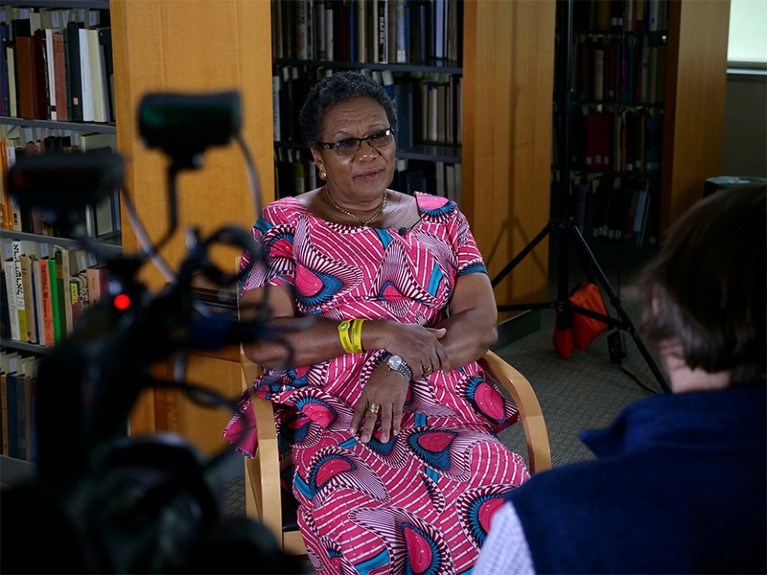
Helena Asomoah-Hassan, university librarian at KNUST, Ghana, being interviewed for Paywall by director Jason Schmitt.Credit: Paywall, 2018
Paywall: The Business of Scholarship Director: Jason Schmitt Open Society Foundations (2018)
Billed as a documentary, Paywall would be more accurately described as an advocacy film. Its intention seems to be to persuade viewers that the paywalls that restrict access to journal content online are an unnecessary hangover from the print era, and now serve only to perpetuate the excessive profits that legacy publishers such as Elsevier, Wiley and Springer Nature make from the public purse.
The film makes a convincing case that the paywall system creates problems — and that universal open access (OA) to scholarly articles would be better for society. But it fails to adequately explore the thorny challenges that arise with OA publishing. These include the fact that the publishers castigated by the film would continue to dominate scholarly communication in an OA world; the increasingly expensive ‘pay-to-publish’ model, which substitutes inequities in access for inequities in affording publication; and the rise of predatory publishing. And although Paywall acknowledges that current reward systems have slowed the progress of OA publishing, it does not address the puzzling question of why academics have proved so reluctant to make copies of their published papers freely available in their institutional repositories.
Paywall features more than 70 interviews. People represented include: Richard Wilder, associate general counsel at the Bill & Melinda Gates Foundation; Wikipedia Library head Jake Orlowitz; and Alexandra Elbakyan, founder of Sci-Hub (a website that offers free access to more than 70 million illegally downloaded academic papers). Rachel Burley, publishing director for BioMed Central and SpringerOpen, speaks for Springer Nature.
The film ranges over issues such as journal price inflation, researcher evaluation and impact factors, and the disparity of access between the predominantly wealthy global north and the mostly lower-income global south. The film is funded by the Open Society Foundations in New York City, which was created by philanthropist George Soros in 1993, and was instrumental in the formation of the OA movement.
Director Jason Schmitt — a scholar of communications and media at Clarkson University in Potsdam, New York — made the film to bring the discussion to the public at large. Yet most of the screenings are scheduled at universities, so how broad an audience it will find is an open question.
Schmitt wrote to me: “Publishing top-tier research journals is complex and costly. I know publishers provide an important service. But I feel that at the current technological bandwidth, we don’t need the sheer number of journals controlled by large publishers.” He describes the scholarly publishing market as a US$25.2-billion-a-year industry. Heather Joseph, executive director of the global OA advocacy group the Scholarly Publishing and Academic Resources Coalition, puts the figure at $10 billion.

Oxford University recently ran out of funds for some OA publication charges.Credit: Jim Richardson/NGC/Getty
The film singles out Elsevier for most criticism, eliding the fact that the company is simply more successful than most for-profit legacy publishers at doing what they all do. Schmitt wrote me that he tried to achieve balance, but that Elsevier declined to be part of the film, so it was unable to “show the positives and attributes of their business model”. Instead, the witness for the defence is Will Schweitzer, product-development director at the American Association for the Advancement of Science in Washington DC, publishers of Science and other journals. He says: “Do we act effectively as a responsible midwife for these important scholarly concepts or ideas, and make them accessible to the world and distribute them, and reinvest in the community? I would say yes.”
Subscriptions, Schmitt argues, unnecessarily restrict access to research. Moreover, prices routinely increase faster than inflation — and library budgets — so journal subscriptions are regularly cancelled, and paywalls grow.
Paywalls hit researchers from the global south hardest. A 2001 World Health Organization (WHO) survey found that 56% of research institutions in very low-income countries had no subscriptions to international scientific journals. To address this, global agencies worked with major publishers to offer researchers in poorer countries free or low-cost access to articles. Initiatives include the Hinari Access to Research for Health Programme, run by the WHO, and Access to Global Online Research in Agriculture, run by the Food and Agriculture Organization of the United Nations (these programmes and others have now been subsumed under Research4Life). Yet these initiatives are regularly criticized for creating dependency and “commodifying legitimacy”.
The film offers telling examples. Nigerian physician Ahmed Ogunlaja, for instance, explains that local doctors are constantly confronted with paywalls. Another interviewee — Tom Callaway, head of outreach to universities at open-source software company Red Hat in Raleigh, North Carolina — relates that he could not afford to research his wife’s pulmonary embolism. Without a subscription, each paper costs an average of $30–40, and it is not possible to know whether they are relevant before paying.
I agree with the film that universal OA is far preferable to subscriptions. Combined with open data, it would make science more efficient, not least because more scholars, independent researchers and citizen scientists would be able to contribute to and build on published work. Greater openness could also help to address problems of reproducibility, fraud and research misconduct. And the increasingly interdisciplinary work necessary to address grand societal challenges — from climate change to food security — is better enabled by OA.
The film mentions ‘green’ OA (in which researchers deposit copies of their own papers in online repositories), but seems more focused on ‘gold’ OA, in which publishers make papers freely available.
The weakness of Paywall is that it fails to adequately address the challenges of OA. Among the biggest are article-processing charges (APCs). The now-dominant OA model pioneered by publishers PLOS and BioMed Central, both founded in 2000, demands that authors or their funders pay APCs to make work freely available. But many cannot afford the charges, even at leading universities in wealthy nations. Legacy publishers all now also offer gold options that set APCs at levels designed to preserve current profits. Thus, the very publishers that Paywall criticizes will continue to dominate, because (as the film points out) researchers have incentives to publish in their prestigious journals. And for those in the global south, APCs are invariably unaffordable. Waivers are sometimes available, but authors often find they are not eligible. The problems of both affordability and equity will persist.
The film also fails to discuss other pressing issues. These include a lack of consensus on exactly what OA is and how it should be achieved, and the continuing indifference to it in the research community — consider that many academics do not self-archive their papers even when mandated to do so. Moreover, because many OA papers have no licence attached, they are susceptible to being placed behind a paywall later, making openness a fragile condition. It’s ironic, too, that the most successful OA initiative is Sci-Hub.
As a piece of advocacy, Paywall is compelling enough to attract new converts. It will not, however, educate the public in the complexities of open access.

 Europe’s open-access drive escalates as university stand-offs spread
Europe’s open-access drive escalates as university stand-offs spread
 How Unpaywall is transforming open science
How Unpaywall is transforming open science
 Science journals end open-access trial with Gates Foundation
Science journals end open-access trial with Gates Foundation
 The future of publishing
The future of publishing
 Open access at Nature Research
Open access at Nature Research




